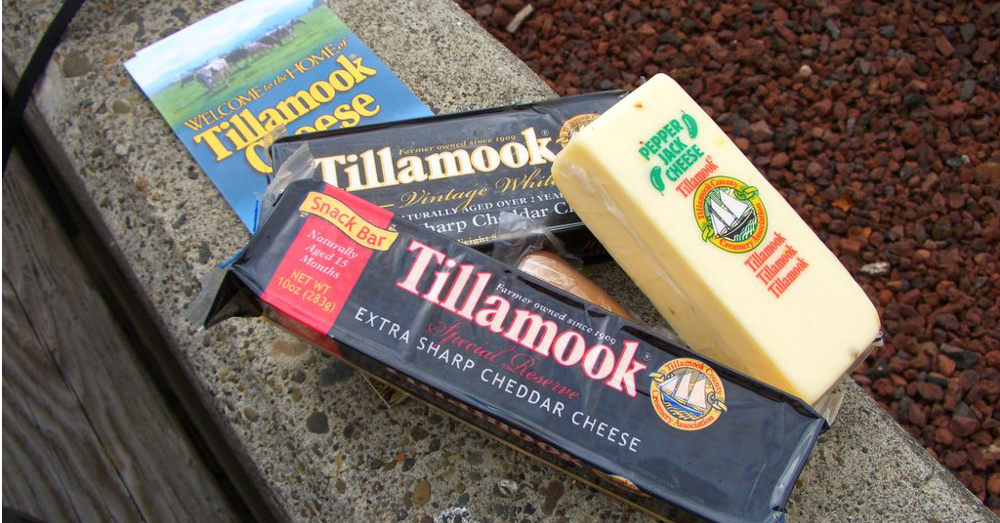
Why I’m Quitting Tillamook Cheese
It turns out that only a portion of the milk that is used by the Tillamook County Creamery Association (TCCA)* to make their famous cheeses is produced by those cows munching that rich, coastal grass. Instead, Tillamook has partnered with Threemile Canyon Farms in Boardman on the Columbia River, a factory farm that produces around 2 million pounds (that's 233,000 gallons, folks) of milk per day from 30,000 milk cows kept during the entirety of their short lives in confined barns. Add to that another 40,000 animals consisting of calves and "replacement heifers," young females that will be added to the milking herd at two years old.
March 17, 2017 | Source: Good Stuff NW | by Kathleen Bauer
“As Oregonian as a lumberjack sharing a craft beer with a beaver, no one does cheese like Tillamook.” – New Seasons sale flyer
Their packaging says “Thank you for buying Tillamook and keeping our family farms strong.”
Since childhood I’ve been a fan of Tillamook cheese. Molten and gooey inside grilled cheese sandwiches, grated into mac and cheese and melted over just about anything you can think of, its bright orange hue has been a color theme weaving through my life. On trips to the coast my parents would stop the station wagon at the cheese factory to follow the steps that the milk took from liquid to curd to sliced chunks which were finally pressed into logs, aged and dipped in wax (now wrapped in plastic) to be displayed on refrigerated shelves.
On those same trips my parents would point out the cows munching grass in the brilliant green coastal pastures of Tillamook County, their pendulous udders swaying as they moved to the barns to be milked twice a day. “That’s where our cheese comes from!” we’d think.
That’s why it is with a heavy heart that I’ve finally decided to give up Tillamook cheese. It’s not because the flavor has somehow fallen off of a cliff, or that I’ve discovered a better product—their extra sharp white cheddar had become our house cheese after my husband developed an intolerance to lactose. (Lactose is converted to lactic acid by cultures added to the cheese, and the longer it’s aged, the less lactose remains.)
So why have I reached this decision?
It turns out that only a portion of the milk that is used by the Tillamook County Creamery Association (TCCA)* to make their famous cheeses is produced by those cows munching that rich, coastal grass. Instead, Tillamook has partnered with Threemile Canyon Farms in Boardman on the Columbia River, a factory farm that produces around 2 million pounds (that’s 233,000 gallons, folks) of milk per day from 30,000 milk cows kept during the entirety of their short lives in confined barns. Add to that another 40,000 animals consisting of calves and “replacement heifers,” young females that will be added to the milking herd at two years old.
As for the amount of milk produced in Tillamook County itself, a report from 2014 titled “Tillamook County Community Food Assessment: Growing Healthy Communities on the North Oregon Coast” noted that at that time “the cooperative…gets more than half its milk from outside Tillamook County and does a portion [of its] other cheese making and distribution from Boardman, Oregon.”
An article in the Tillamook Headlight Herald from 2012, announcing layoffs of 50 employees doing packaging at the Tillamook processing facility—outsourced to companies in Utah and Idaho—quoted then-TCCA CEO Joe Rocha as saying that “all ice cream is made in Tillamook. Other Tillamook brand products, such as yogurt, butter and sour cream, are licensed products produced by other companies. All local milk is processed in Tillamook.”
Tillamook has also built a large cheese processing facility, Columbia River Processing, near Threemile Canyon Farms in Boardman that was designed to produce 58 million pounds of cheese a year at full operation. In 2014 it built a 64,000-square-foot expansion project to process whey, which is used in products like infant formula, performance nutrition products and products that “help manage some of the impacts of aging.”
